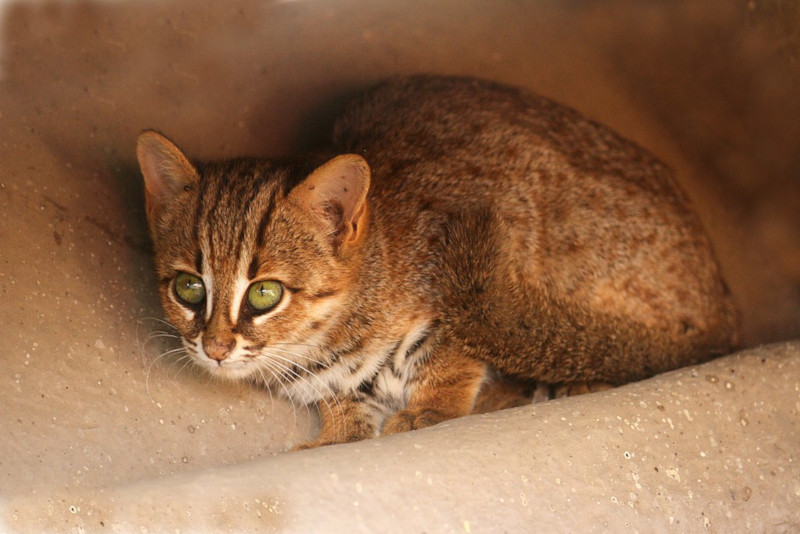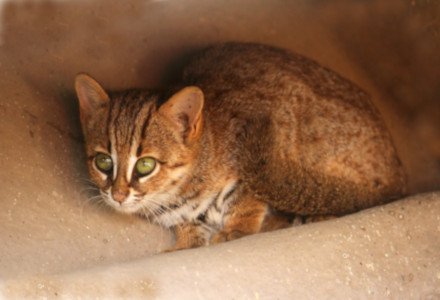
Rusty-Spotted Cat Facts
- The term of Rusty-Spotted Cat perfectly serves as the common name for this beautiful wild feline. It’s also far more pronounceable than the scientific name for the animal. That’s because that term’s the tongue-twisting name of Prionailurus rubiginosus.
- It’s held several other scientific names , though. The first scientific recognition, and naming, of the animal occurred in 1831, through the efforts of the French zoologist Isidore Geoffroy Saint-Hilaire. Several other proposed names later followed.
- Whichever name one uses for the magnificent mammal, however certain facts stand out about it. The primary one remains the fact that it’s quite a diminutive member of the cat family. In fact, it currently ranks as one of the smallest of all known wild felines.
- Sadly, like many of the species of the world, the Rusty-Spotted Cat now finds itself in peril. Its population numbers appear to be dwindling rapidly, for various reasons. As a result, the IUCN now lists the mammal as Near Threatened on its Red List.
- For the moment, habit loss appears to be the primary factor behind its decline. This occurs mainly due to its native habit being destroyed as part of cultivation efforts by humans. It also, however, now faces the threat of climate change, like other species.
Related Articles
Rusty-Spotted Cat Physical Description
The fabulous Rusty-Spotted Cat elegantly proves the principle that beauty comes in all shapes and sizes. That’s because, by any measure, it’s a small species of feline, despite its great appeal. Nature continually demonstrates its apparent love of variety in its creations.
Like many mammals, though, this remarkable variety of wild cat displays the physiological characteristic of sexual dimorphism. It further follows the pattern of the majority of felines in that this trait primarily manifests itself in terms of sheer physical size.
More precisely, the males attain a greater average body weight than the females. That difference, however, remains comparatively minor. A male reaches an average body weight of roughly 3.75 lb (1.7 kg.) The slightly smaller female, meanwhile, averages about 3.1 lb (1.4 kg).
In terms of overall appearance, though, the genders appear essentially indistinguishable. Typically, the fur develops as quite short, and mainly displays a brownish color across most of the body. It further shows a mild rusty tinge, hence the common name.
The animal does, though, present a different pattern on the throat and the underside of the body. There, the fur develops as a light white. It’s also marked with random dark stripes and spots. Typically, individuals also have four dark stripes extending back from over the eyes.
- Kingdom: Animalia
- Phylum: Chordata
- Class: Mammalia
- Order: Carnivora
- Family: Felidae
- Genus: Prionailurus
- Species: P. rubiginosus
Rusty-Spotted Cat Distribution, Habitat, and Ecology
Lamentably, the Rusty-Spotted Cat only appears to inhabit a very small portion of the globe. In this instance, that region covers a tiny section of the continent of Asia. More specifically, the only known habitat range of the animal consists of portions of Sri Lanka and India.
Its main habitat remains very specific in nature. The majority of individuals appear in regions of relatively dry forests. In recent years, however, small groups have begun to appear in agricultural areas inhabited by humans. The exact reason for this remains unknown.
Yet its adaptability does not end there. Perhaps in response to human encroachment on its natural territory, groupings now appear to be expanding their range. In fact, a few scattered individuals now inhabit both tropical and semi-arid areas.
Evidence indicates that the Rusty-Spotted Cat evolved as a mainly solitary animal. Most individuals live alone, and usually remain within clearly defined personal territories. Although mainly terrestrial in nature, it also displays tendencies toward arboreal activities.
Like its many related species, this mammal also evolved as carnivorous in nature. Given its size, its prey typically consists of smaller creatures. This largely consists of small birds and other mammals. Yet it also feeds opportunistically, including eating insects such as crickets.
Somewhat surprisingly for researchers, it appears to have no natural predators. It must be pointed out, however, that detailed studies of its habits and life cycle remain few. Most likely, it falls prey to a variety of larger carnivores sharing its native range.
Species Sharing Its Range
Check out our other articles on 4 Magnificent Land Mammals of Mexico, Bowmouth Guitarfish, Namib Desert, Arrowleaf Elephant Ear, Conehead Mantis, Jackson’s Chameleon

